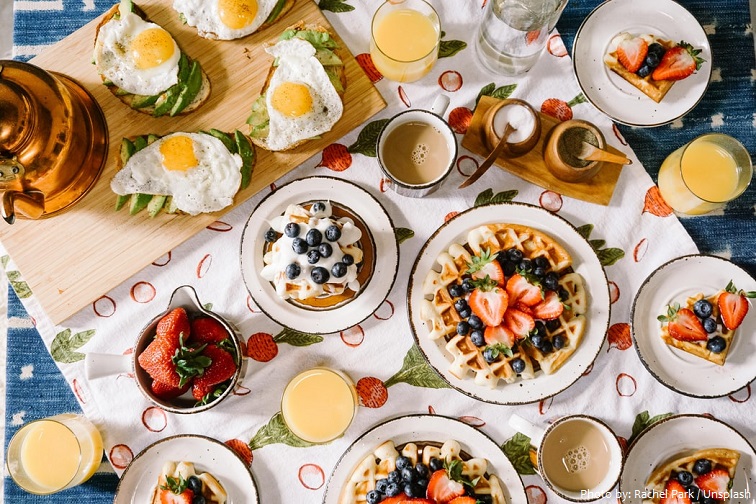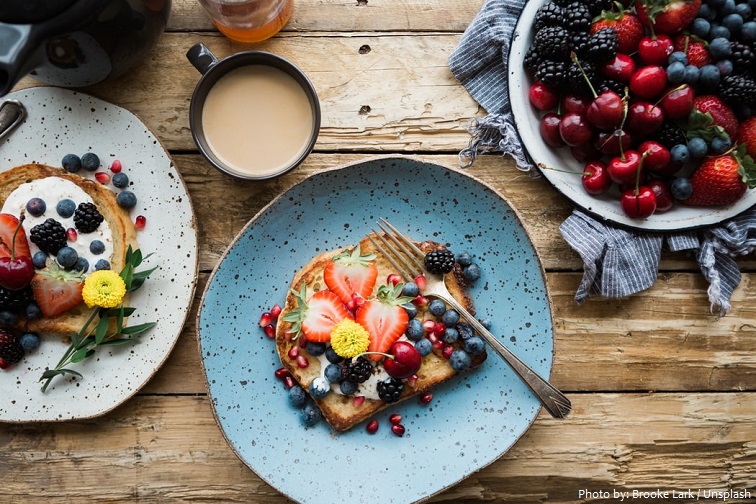
Brunch is a combination of breakfast and lunch, and regularly has some form of alcoholic drink (most usually champagne or a cocktail) served with it.
It is usually served anytime before 2 o’clock in the afternoon.
The word “brunch” is a portmanteau of breakfast and lunch.
Many believe the first brunches to have been England’s hunt breakfasts, which were a feast of meats hunted that day, along with eggs, stews, fruits and sweets.

Others believe it was the Catholics who first enjoyed a late-morning brunch, a result of their early-morning pre-church fasting.
It was first written about in August 1895 by writer Guy Beringer, who really wanted an excuse to sleep in late on Sundays. So he invented a meal that would let him do just that. The meal writer Guy Beringer invented has become a cultural phenomenon.
It proliferated first in Victorian Britain among the upper class, who would dine late after a fun morning spent hunting.

It was eventually exported to urban America, and evidence suggests that by the 1920s, New York, New Orleans, and Chicago all had their own brand of fledgling brunch culture. (In Chi-town, the meal livened up a bicoastal celebrity’s transcontinental train stopover.)
According to one brunch historian, the late-morning meal became chic in the 1930s, when Hollywood stars making their way across country on trains would stop in Chicago to enjoy a late morning meal. Thanks to its celebrity boosters, brunch became a hit.
By the 1930s, there was a veritable brunch boom, and in 1939, the Times declared Sundays to be officially a two-meal day. Of course, the food people brunched on might look a bit unfamiliar to modern diners: A 1940s Times article notes that Fifth Avenue Hotel served a “Sunday Strollers’ Brunch’’ which was comprised of “sauerkraut juice,” “clam cocktails,” and “chicken liver omelet.”

Church attendance declined sharply after World War II, which only helped the growing brunch trend.
After World War II, large numbers of American married women entered the workforce for the first time. Married women needed a relief on Sunday, too, thus the rise in popularity of Sunday brunch eaten out.
The 1980s ushered in a brunch culture that most influenced the brunches we enjoy today. The age of conspicuous consumption saw the introduction of lavish brunch buffets, harkening back to its American origins as a meal for the wealthy upper class.
Today, brunch may owe its prominence in pop culture to the ladies of Sex and City, making it no surprise that Food & Wine magazine named New York City the best brunch city in the United States.

Eggs benedict, perhaps the most famous of brunch dishes, was invented in NYC, with the city’s brunch menus also frequently featuring local favorites, like Nova lox and smoked sturgeon.
Omelets are also very popular brunch dish. However omelettes can be eaten as a light lunch or late evening meal. The earliest omelettes are believed to have originated in ancient Persia.
Brunch is prepared by restaurants and hotels for special occasions, such as weddings, Valentine’s Day, St. Patrick’s Day, Mother’s Day, Father’s Day, Halloween, Thanksgiving, Christmas, New Year’s or Easter.
The area now known as Leslieville neighbourhood is sometimes called the brunch capital of Toronto as many renowned establishments serve brunch in that neighbourhood.

The dim sum brunch is popular in Chinese restaurants worldwide. It consists of a variety of stuffed buns, dumplings, and other savory or sweet food items that have been steamed, deep-fried, or baked. Customers
pick small portions from passing carts, as the kitchen continuously produces and sends out more freshly prepared dishes. Dim sum is usually eaten at a mid-morning, midday, and/or mid-afternoon teatime.
The Office québécois de la langue française accepts “brunch” as a valid word but also provides a synonym déjeuner-buffet.
Data from Google Trends show that search interest in brunch has been rising steadily since 2004.